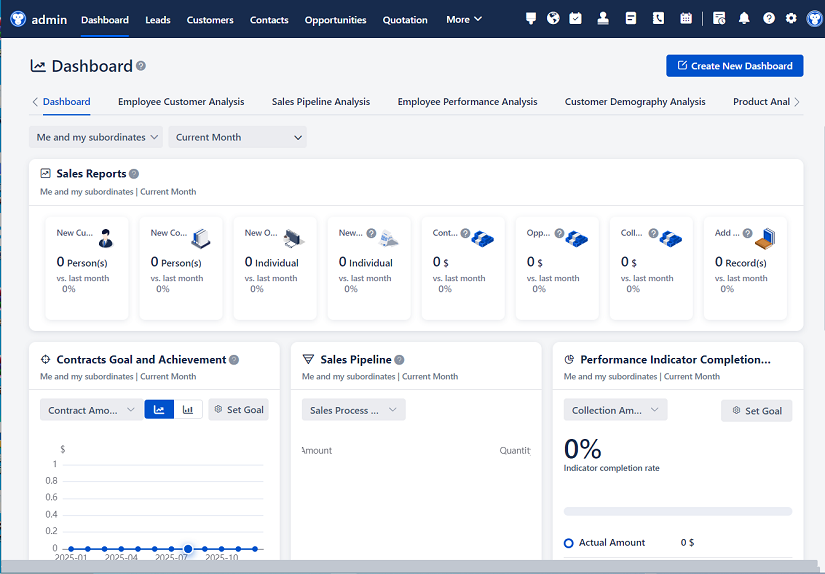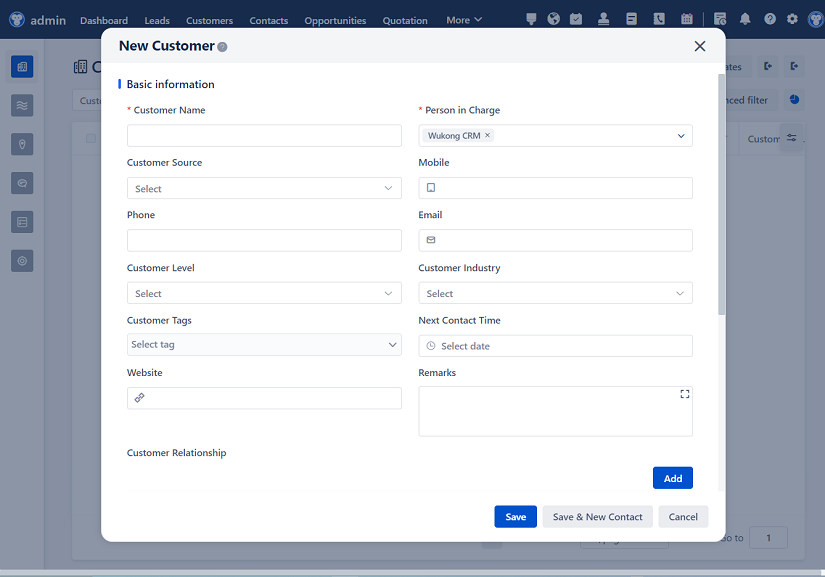
△Click on the top right corner to try Wukong CRM for free
You know, running a business these days can feel like trying to juggle ten things at once while riding a unicycle. I mean, think about it—customers expect fast responses, personalized service, and seamless experiences, all while your team is scrambling to keep up with emails, calls, spreadsheets, and endless follow-ups. It’s exhausting. And honestly, without the right tools, it’s easy to drop the ball. That’s where CRM systems come in. I’ve seen firsthand how they can turn chaos into clarity.
Let me tell you something—before we implemented a CRM, our sales team was basically flying blind. They’d call leads they hadn’t followed up with in weeks, forget who said what during meetings, and lose track of who was even interested. It was a mess. But once we started using a CRM, everything changed. Suddenly, every interaction was logged, every follow-up was scheduled, and everyone on the team could see exactly where each lead stood. It wasn’t magic—it was just good organization.
Free use of CRM system: Free CRM
And here’s the thing: a CRM isn’t just for sales. I used to think it was just a fancy contact list, but man, was I wrong. Marketing teams use it to track campaigns, see who’s opening emails, and figure out which messages actually work. Customer service teams use it to pull up a customer’s entire history in seconds, so they don’t have to ask, “So, what was your issue again?” It’s like giving every department a shared brain.
One of the biggest headaches we had was communication gaps. Sales would promise something to a client, but customer service wouldn’t know about it. Or marketing would launch a campaign, but sales wouldn’t get the memo. It was like everyone was working in their own little silo. But with a CRM, all that info lives in one place. Now, when a customer calls, the rep can see the whole story—every email, every call, every note. It’s not just convenient; it builds trust.
I remember this one time a customer called furious because they thought we’d forgotten about their request. But thanks to the CRM, the support agent pulled up the ticket, saw it had been passed between two departments, and resolved it in five minutes. The customer was shocked—“You actually remember me?” That’s the power of having a system that keeps everything together.
Another thing—lead management. Ugh, that used to be such a nightmare. We’d get leads from the website, trade shows, referrals, you name it. But half the time, they’d just sit in someone’s inbox or get lost in a spreadsheet. No follow-up, no nurturing, just… gone. With a CRM, we set up automated workflows. As soon as a lead comes in, it gets tagged, assigned, and added to a follow-up sequence. No more dropping the ball.

And let’s talk about data. I used to sit in meetings where people would argue about numbers—“No, we closed 15 deals last month!” “Are you sure? I thought it was 12.” It was ridiculous. Now, with the CRM’s reporting tools, we just pull up the dashboard. Real-time data, accurate numbers, no guessing. It’s not just helpful for leadership—it helps sales reps see their own performance and adjust their strategies.
You know what else? Personalization. Customers hate feeling like just another number. But without a CRM, how do you remember that Mrs. Johnson prefers email over phone calls, or that Company X is interested in Feature Y? It’s impossible. But with a CRM, you can store all those little details. So when you reach out, you can say, “Hi Sarah, I saw you downloaded our guide on automation—want to chat about how it could help your team?” That kind of personal touch? Huge difference.
I’ve also noticed that onboarding new team members is way easier now. Instead of spending weeks shadowing people or digging through old emails, they can just log into the CRM and see how things are done. What’s the sales process? Check the pipeline stages. What’s the standard follow-up email? Pull up a template. It cuts down training time and gets people productive faster.
And don’t even get me started on mobile access. I was on vacation once—actually, I was at the beach—and I got a call from a key client with an urgent question. I pulled out my phone, opened the CRM app, checked their account history, and gave them the answer right then and there. The client was impressed, and honestly, so was I. That kind of flexibility? Priceless.
Now, I’ll be honest—not every CRM is perfect. We tried one early on that was way too complicated. Too many fields, too many clicks, and nobody wanted to use it. That’s a lesson learned: if your team doesn’t adopt it, it’s useless. So we switched to a simpler, more intuitive system. And we made sure to train everyone, not just once, but regularly. Because a CRM is only as good as the data in it, and that depends on people actually using it.

Another big win? Forecasting. Before, our sales forecasts were basically educated guesses. “Well, Bob says he might close this deal…” Now, the CRM analyzes pipeline data, win rates, deal stages, and gives us a much more accurate prediction. It helps with budgeting, staffing, and setting realistic goals. No more overpromising and underdelivering.

Customer retention is another area where CRM shines. We used to lose customers and not even realize why. Now, we track satisfaction scores, support tickets, and engagement levels. If someone hasn’t logged into our platform in a while, the CRM flags them, and we reach out with a check-in. It’s proactive, not reactive. And guess what? Our churn rate has dropped.
I’ve also seen how CRMs help with collaboration. Sales and marketing used to be at odds—marketing would say, “We’re generating great leads!” and sales would say, “Yeah, but they’re not qualified.” Now, with shared dashboards and lead scoring, they’re on the same page. Marketing sees which leads convert, and sales sees which campaigns bring in the best prospects. It’s teamwork, finally.
And let’s not forget automation. I used to spend hours copying data from emails into spreadsheets. Now, the CRM does it for me. Follow-up emails? Automated. Meeting reminders? Scheduled. Data entry? Mostly handled. It frees up time for actual selling and relationship-building, which is what really matters.
Security is another thing people don’t think about until it’s too late. We had a laptop stolen once—thankfully, all customer data was in the CRM with role-based access. No one outside the company could see anything. It gave us peace of mind knowing our clients’ info was safe.
Integration is huge too. Our CRM connects with our email, calendar, accounting software, and even our website chat. So when someone fills out a form, it goes straight into the CRM. No manual entry, no delays. It’s like everything just flows together.
I’ll admit, implementing a CRM took some effort. There was resistance at first—“We’ve always done it this way.” But once people saw how much easier their jobs became, they came around. And the ROI? Clear as day. We’re closing more deals, faster, with fewer resources.
Another thing—scalability. When we were a small team, we could manage with spreadsheets. But as we grew, that just didn’t work anymore. The CRM scaled with us. Whether we have 10 customers or 10,000, the system handles it. That’s crucial for long-term growth.
And let’s talk about customer experience. In today’s world, that’s everything. A CRM helps you deliver consistent, timely, and personalized service. Whether it’s sending a birthday message, following up after a support call, or recommending a product based on past purchases—it all adds up to a better experience.
I’ve even seen how CRMs help with accountability. When everything is tracked, it’s harder to make excuses. “I forgot to call them” doesn’t fly when the system shows the last activity was three weeks ago. It encourages responsibility and follow-through.
Finally, innovation. The best CRMs aren’t static—they evolve. With AI features now, we get predictive insights, like which leads are most likely to convert or when a customer might be at risk of leaving. It’s like having a smart assistant who knows your business inside and out.
Look, no tool is a silver bullet. A CRM won’t fix bad products or poor service. But it will make everything you do more efficient, more organized, and more customer-focused. And in today’s competitive market, that’s not just nice to have—it’s essential.
So if you’re still managing customer relationships in spreadsheets or sticky notes, do yourself a favor: look into a CRM. Start small, pick one that fits your team’s workflow, and commit to using it consistently. I promise, you’ll wonder how you ever lived without it.
FAQs (Frequently Asked Questions):
Q: Isn’t a CRM just for big companies?
A: Not at all! Small businesses benefit just as much—maybe even more. When you’re small, every customer counts, and a CRM helps you treat them like it.

Q: How long does it take to set up a CRM?
A: It depends on the system and your needs. Simple setups can take a few days; more complex ones might take a few weeks. But you can usually start using basic features right away.
Q: Will my team actually use it?
A: That’s a real concern. Choose a user-friendly system, provide training, and show how it makes their jobs easier. When people see the benefit, adoption goes way up.
Q: Is my data safe in a CRM?
A: Reputable CRM providers use strong security measures like encryption and access controls. Just make sure to choose one with good reviews and compliance certifications.
Q: Can a CRM really improve sales?
A: Absolutely. By organizing leads, automating follow-ups, and providing insights, a CRM helps sales teams work smarter and close more deals.
Q: What if we already use other tools?
A: Most CRMs integrate with email, calendars, marketing platforms, and more. You don’t have to replace everything—just connect them.
Q: How much does a CRM cost?
A: Prices vary. Some have free plans for small teams; others charge per user per month. But when you factor in time saved and deals won, most businesses see a strong return on investment.
Q: Do I need IT support to run a CRM?
A: Not usually. Many modern CRMs are cloud-based and designed for non-tech users. Setup and maintenance are often handled by the provider.
Related links:
Free trial of CRM
Understand CRM software

△Click on the top right corner to try Wukong CRM for free